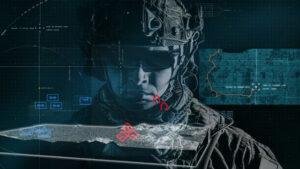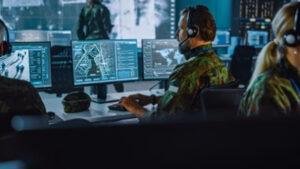- AI Combat Simulations
- armed forces
- Artificial Intelligence
- Combat Simulation.
- Cybersecurity.
- Data processing and Research.
- Drone Swarms.
- Peter Jonathan Wilcheck
- Strategic decision making.
- Target Recognition.
- Threat Monitoring.
- US Department of the Air Force
- US Department of the Army
- US Department of the Navy
- US Department of the Space Force
- Warfare systems.
Fortifying the Frontlines: How Deep Learning AI is Giving the US Military an Unbeatable Edge
"Revolutionizing Warfare: How Deep Learning is Giving the US Military an Unstoppable Edge"
Recently over the course of 16 months, the explosive growth for advanced artificial intelligence (AI) technology to revolutionize the way the armed forces departments operate has become increasingly apparent. AI can provide the armed forces departments with a range of capabilities that can give them an edge over their adversaries. From better situational awareness to improved decision-making, AI has the potential to help the armed forces departments gain a secure leverage over their adversaries, as this si why, Fortifying the Frontlines: How Deep Learning AI is Giving the US Military an Unbeatable Edge will be imperative.
A key advantage of AI is its ability to provide near-instantaneous intelligence gathering and analysis. By leveraging AI-powered sensors and data-driven analytics, the armed forces departments can quickly and accurately identify potential threats, allowing for a rapid response. AI-driven analytics can also be used to detect any suspicious activity, allowing the armed forces departments to take a proactive approach in countering any potential threat.
AI-powered systems can also help the armed forces departments improve their decision-making capabilities. AI-based analytics can provide the armed forces departments with access to real-time data and insights, allowing them to make more informed decisions in the face of rapidly changing situations. AI-powered systems can also help the armed forces departments anticipate potential threats, allowing them to take preemptive measures to counter any upcoming challenges.
Improvements Underway
In addition to improving the armed forces departments’ decision-making capabilities, AI-driven systems can also help them gain a secure leverage over their adversaries. AI-driven analytics can be used to accurately detect any potential threats and to identify any suspicious activity. AI-powered systems can also provide the armed forces departments with access to a wide range of data and insights, allowing them to make more informed decisions.
AI-driven systems can help the armed forces departments improve their communication and coordination capabilities. By leveraging AI-based analytics, the armed forces departments can quickly and accurately identify potential threats and take the necessary measures to counter any potential challenges. AI-driven systems can also help the armed forces departments improve their communication and coordination by providing them with real-time data and insights, allowing them to make more informed decisions.
Now let’s take a quick overview at the US Department’s Armed Forces Department. They are comprised primarily of four (4) major departments. The US Department of Defense is responsible for the security and protection of America’s interests, both domestically and abroad. It is made up of several branches, including the US Army, US Navy, US Air Force, and US Space Force. Let’s take a quick and close look at each of these branches and the roles they play in the US Department of Defense.

Department of the Army
US Department of the Army
The US Army is the oldest of the US military branches and was formed on June 14, 1775. The primary mission of the US Army is to protect the nation and its interests by providing ground forces to support US military operations. The US Army is responsible for maintaining the readiness of its forces to respond to any threat, whether it be a natural disaster or a military conflict.
The US Army is also responsible for providing support to other branches of the US military. This includes providing support to the US Air Force and the US Navy in areas such as logistics and transportation. In addition, the US Army has its own specialized units, including the Special Forces, which are trained to carry out unconventional warfare and counter-terrorism operations.

Department of the Navy
US Department of the Navy
The US Navy is responsible for maintaining America’s control of the seas and protecting its interests around the world. The US Navy is made up of several different components, including submarines, aircraft carriers, and surface ships. The primary mission of the US Navy is to provide maritime security, project power, and maintain freedom of the seas.
One of the key roles of the US Navy is to maintain the readiness of its forces to respond to any threat at sea. This includes conducting training exercises and maintaining a presence in areas where US interests may be threatened. The US Navy is also responsible for providing support to other branches of the US military, including the US Army and the US Air Force.

US Department of the Air Force
The US Air Force is responsible for maintaining America’s air and space superiority. The primary mission of the US Air Force is to provide air support to US military operations and to control the skies. The US Air Force is responsible for maintaining the readiness of its forces to respond to any threat, whether it be in the air or on the ground.
The US Air Force also plays a critical role in intelligence gathering and surveillance. This includes using advanced technology such as unmanned aircraft to gather intelligence and provide real-time information to US military commanders. In addition, the US Air Force has its own specialized units, including the Air Force Special Operations Command, which is responsible for carrying out unconventional warfare and counter-terrorism operations.

US Department of the Space Force
US Department of the Space Force
The newest branch of the US military, the US Space Force, was established in 2019. The primary mission of the US Space Force is to protect America’s interests in space and to maintain America’s space superiority. The US Space Force is responsible for maintaining the readiness of its forces to respond to any threat in space.
One of the key roles of the US Space Force is to protect America’s space-based assets, including satellites and other critical infrastructure. The US Space Force is also responsible for developing new technologies and capabilities to maintain America’s space superiority. This includes developing advanced space-based sensors, communication systems, and other technologies.
How Advanced AI can provide superior leverage over their adversaries especially in these areas of function.

Warfare Systems
The advancements in Artificial Intelligence (AI) have led to numerous applications in different fields, including warfare systems. AI has the potential to revolutionize warfare systems by providing advanced tools to analyze and process data, make informed decisions, and operate weapons systems with increased efficiency and accuracy.
One of the significant benefits of AI in warfare systems is its ability to process large amounts of data quickly and accurately. With the help of AI, military forces can analyze vast amounts of information, such as satellite imagery, radar data, and communication intercepts, to identify potential threats and plan accordingly. This can lead to better situational awareness and decision-making, which is crucial in modern warfare.
Another way AI can help with warfare systems is by improving the accuracy and precision of weapons systems. AI can be used to develop smart munitions that can locate and target specific objects or individuals with greater accuracy. This can reduce collateral damage and civilian casualties, which is essential in modern warfare, where minimizing civilian casualties is a top priority. These systems can be programmed to perform specific tasks, such as reconnaissance, surveillance, and target acquisition, without risking human lives.
This can lead to more effective and efficient operations, as autonomous systems can operate in environments that are too dangerous for human operators. In conclusion, the use of AI in warfare systems has the potential to revolutionize the way military forces operate. AI can help with the processing and analysis of data, improve the accuracy and precision of weapons systems, and develop autonomous systems that can operate without human intervention. However, the use of AI in warfare systems also raises ethical concerns, and it is essential to ensure that the development and use of AI adhere to international humanitarian law and ethical standards.

Strategic Decision Thinking
With the rapid development of technology, warfare systems have become increasingly complex, and the need for advanced decision-making tools has never been greater. AI can be used to analyze vast amounts of data and provide real-time insights that can help military leaders make more informed decisions.
One of the key benefits of AI in military strategic decision thinking is its ability to process and analyze large amounts of data quickly and accurately. This can help military leaders gain a better understanding of the battlefield and identify potential threats and opportunities. By using AI to analyze data from various sources, including sensors, satellites, military leaders can gain a more comprehensive view of the battlefield and make better-informed decisions.
Another advantage of AI in military strategic decision thinking is its ability to learn from past experiences. By analyzing historical data, AI can identify patterns and trends that can help military leaders predict future events and make more accurate decisions. This can be particularly useful in situations where there is limited information available, such as in covert operations or during the early stages of a conflict.
AI can also be used to simulate various scenarios and test different strategies, allowing military leaders to evaluate the potential outcomes of their decisions before they are implemented. This can help reduce the risk of making costly mistakes and improve the overall effectiveness of military operations.
AI has the potential to transform military strategic decision thinking by providing real-time insights, analyzing historical data, and simulating different scenarios. As warfare systems continue to evolve, it is becoming increasingly important for military leaders to have access to advanced decision-making tools that can help them stay one step ahead of their adversaries.

MILITARY DATA PROCESSING AND RESEARCH and Ai
Data Processing and Research
The integration of advanced AI technology can significantly boost the military’s data processing and research capabilities. AI-powered systems can analyze vast amounts of data in real-time, allowing military personnel to make more informed decisions and respond to threats quickly. With the help of AI, the military can process and analyze a wide range of data, including satellite imagery, surveillance footage, and intelligence reports.
AI’s impact on the military’s data processing and research capabilities is the use of predictive analytics. Predictive analytics uses machine learning algorithms to identify patterns and predict outcomes based on historical data. This technology can help the military anticipate potential threats and respond proactively, rather than reactively. Additionally, AI-powered systems can be used to identify and track high-value targets, monitor supply chains, and analyze enemy communications.
Advanced AI and Data Processing and Research Examples
Another real-life example of AI’s potential in the military is the development of autonomous weapons systems. Autonomous weapons are equipped with AI-powered algorithms that enable them to make decisions and take action without human input. These weapons can be used to conduct reconnaissance missions, identify targets, and even engage in combat. Although the use of autonomous weapons is still a controversial topic, their potential to reduce human casualties and improve military efficiency cannot be ignored.
The military can greatly benefit from advanced AI technology in data processing and research. With the ability to analyze vast amounts of data and make informed decisions in real-time, AI-powered systems can help the military to stay ahead of potential threats and respond proactively.

AI AND COMBAT SIMULATIONS
Combat Simulations
Advanced Artificial Intelligence (AI) has revolutionized the military and defense industry, providing unparalleled benefits and opportunities. One of the most significant applications of AI in the military is in combat simulations. The simulations allow the military to train their soldiers in a safe environment, without risking human lives or expensive equipment.
AI can assist the military in various ways during combat simulations. For instance, AI can help create an accurate representation of the battlefield, including terrain, weather, and enemy forces. Additionally, AI can analyze the behavior and decision-making of both friendly and enemy forces, which can help the military develop effective strategies and tactics.
Combat Simulation examples
One of the most notable examples of AI-powered combat simulations is the US military’s Synthetic Training Environment (STE) program. The STE program uses AI to provide realistic training simulations for soldiers, allowing them to hone their skills and prepare for real-life scenarios. The program utilizes machine learning algorithms to create intelligent and adaptive virtual enemies that can respond to the soldiers’ actions in real-time. The program has been successful in improving the effectiveness of the military’s training and preparedness.
Another example of AI-powered combat simulations is the Joint Conflict and Tactical Simulation (JCATS) system. The JCATS system creates a real-time simulation of the battlefield, including the behavior of friendly and enemy forces. The system can also simulate various combat scenarios, including air, land, and sea operations. The JCATS system has been used by the US military and its allies to train soldiers, plan military operations, and evaluate new weapons and technologies.
AI-powered simulations provide a safe and cost-effective way for soldiers to train and prepare for real-life scenarios. The use of AI can also help the military develop effective strategies and tactics by analyzing the behavior of both friendly and enemy forces. The US military’s Synthetic Training Environment and Joint Conflict and Tactical Simulation systems are examples of how AI is transforming military training and preparedness. The future of AI in the military is bright, and we can expect to see more innovative applications of AI in combat simulations and other defense-related fields.

MILITARY TARGET RECOGNITION AND AI
Target Recognitions
Advanced AI has been making significant strides in the field of military technology, particularly in target recognition. Target recognition is a critical aspect of military operations, and it involves the ability to identify and classify targets accurately and quickly. The use of advanced AI in target recognition can significantly enhance the military’s ability to identify potential threats and respond appropriately.
One of the primary benefits of using AI in target recognition is its ability to process vast amounts of data in real-time. AI algorithms can analyze large datasets, such as satellite imagery, radar data, and video feeds, and identify potential targets with a high degree of accuracy. This can save valuable time and resources, allowing the military to respond quickly to potential threats.
Target Recognition Examples
There have been real-life examples where advanced AI has been used in target recognition by the military. For instance, the United States military has been using AI-powered drones to identify and track potential targets in Afghanistan and Iraq. These drones use advanced AI algorithms to analyze video feeds and identify potential threats in real-time.
Another example is the use of AI-powered computers to analyze satellite imagery and identify potential targets. The Chinese military has been using AI-powered computers to analyze satellite imagery to identify potential threats, such as enemy ships or aircraft.
The use of advanced AI in target recognition has significant potential to enhance the military’s ability to identify and respond to potential threats quickly and efficiently. With the continued development and refinement of AI algorithms, we can expect to see even more advanced applications of AI in military technology in the coming years.

Military Threat Monitoring
Threat Monitoring
Advanced AI or Artificial Intelligence has revolutionized the way organizations function in today’s world. The military sector is no exception. Over the years, the military has been exploring new ways to integrate AI into its operations to enhance its capabilities in threat monitoring. AI technology can be utilized to process large amounts of data and identify patterns that would be difficult for humans to detect. This technology can help the military in threat monitoring by analyzing vast amounts of data from various sources, such as satellites, drones, and ground sensors, to identify potential threats and provide real-time alerts.
One of the most significant advantages of using AI for threat monitoring is its ability to analyze data in real-time. AI algorithms can process data from multiple sources simultaneously, which can help military personnel to respond quickly to threats. With AI, the military can monitor large areas, such as oceans, borders, and airspace, in a more efficient manner. AI systems can also learn from past data and make predictions about future events, which can help the military to be better prepared for potential threats.
Threat monitoring examples:
There are several real-life examples of how AI has helped the military in threat monitoring. The US Air Force has been using AI algorithms to analyze data from unmanned aerial vehicles (UAVs) to identify potential threats. The system can detect changes in the environment, such as new buildings or vehicles, and alert military personnel in real-time. The US Army also uses AI to monitor social media to detect potential threats. The system can identify keywords and phrases that indicate a potential threat and provide real-time alerts to military personnel.
Advanced AI technology has immense potential to help the military in threat monitoring. With its ability to process large amounts of data in real-time and identify patterns that would be difficult for humans to detect, AI can significantly enhance the military’s capabilities in monitoring potential threats. Real-life examples have demonstrated how AI can be utilized to monitor unmanned aerial vehicles and social media to provide real-time alerts to military personnel. As AI technology continues to evolve, it is imperative that the military continues to explore new ways to integrate this technology into its operations to stay ahead of potential threats.

Military Drone Swarming
Drone Swarms
The use of advanced AI in military drone swarms has been gaining much attention in recent years due to its potential for increased effectiveness and efficiency in combat. AI-powered drone swarms can provide a significant advantage to military forces in terms of surveillance, reconnaissance, and attack capabilities. The technology can be used to deploy large numbers of drones to perform various tasks simultaneously, making it easier to cover a large area in a short amount of time.
One of the advantages of AI-powered drone swarms is their ability to operate autonomously. This means that they can be programmed to carry out specific tasks without the need for human intervention. This can help reduce the risk to human life in dangerous situations and allow for more efficient use of resources. Additionally, AI-powered drone swarms can adapt to changing situations and adjust their tactics accordingly, making them more effective in combat scenarios.
Drone Swarm Examples
There have been several real-life examples of how AI-powered drone swarms have been used in military operations. For instance, the US Army has been experimenting with the use of drone swarms in various combat scenarios. In 2019, the Army conducted a demonstration of a drone swarm system that was capable of performing reconnaissance missions and providing real-time surveillance of the battlefield. The system was able to detect and track moving targets and relay the information back to the command center, allowing for more effective decision-making.
In another example, the Chinese military has been developing and testing drone swarms for both reconnaissance and attack missions. The drones can be launched from a variety of platforms, including land-based vehicles, ships, and aircraft. The Chinese military has also demonstrated the use of AI-powered drone swarms in a simulated urban combat scenario, where the drones were able to identify and target enemy soldiers and vehicles.
The use of advanced AI in military drone swarms has the potential to provide significant benefits in combat situations. The technology can be used for a variety of tasks, including surveillance, reconnaissance, and attack missions, and can operate autonomously, reducing the risk to human life. While there have been real-life examples of AI-powered drone swarms in military operations, there is still much research and development to be done in this field. As the technology continues to evolve, it is likely that we will see even more advanced and effective drone swarm systems in the future.

US Military Cyber Security
Cybersecurity
The advancements in Artificial Intelligence (AI) have revolutionized the way we approach cybersecurity. The military has been quick to adopt these technologies and integrate them into their cybersecurity operations. Advanced AI algorithms can analyze large amounts of data and detect potential threats faster than ever before. This has proven to be a game-changer in the fight against cyber attacks.
One of the primary ways that advanced AI can help the military in cybersecurity is by enhancing threat detection capabilities. Traditional cybersecurity methods rely on human analysts to identify and respond to potential threats. However, with the sheer volume of data that needs to be analyzed, it can be difficult for humans to keep up. AI-powered systems can quickly identify patterns and anomalies in data, allowing for faster threat detection and response times.
Another way that AI can help the military in cybersecurity is by improving incident response. In the event of a cyber attack, every second counts. AI-powered systems can quickly analyze the attack and provide insights into how to respond. This can help to minimize damage and prevent further attacks.
Advanced AI and Armed Forces Cybersecurity
Real-life examples of advanced AI being used in military cybersecurity are numerous. The US Department of Defense has been investing heavily in AI-powered cybersecurity tools, such as the Cyber Hunting at Scale (CHASE) program. CHASE is an AI-powered system that can analyze large amounts of data to identify potential cyber threats. The US Air Force has also been using AI to improve its cybersecurity capabilities. The Air Force’s Advanced Battle Management System (ABMS) uses AI to detect and respond to potential cyber attacks in real-time.
Advanced AI has the potential to revolutionize the way the military approaches cybersecurity. By enhancing threat detection capabilities and improving incident response times, AI-powered systems can help to prevent cyber attacks and minimize damage. Real-life examples of AI being used in military cybersecurity demonstrate the effectiveness of these technologies in protecting against cyber threats. As AI continues to evolve and improve, we can expect to see even more advanced cybersecurity tools being developed to keep our military and nation safe.

US Department of Defense
Will the Department of Defense invest in the needed Advanced Artificial Intelligence now and in the future?
The Department of Defense has been investing heavily in advanced artificial intelligence (AI) technologies in recent years. While there is no official figure on how much the department has spent on these technologies, it is known that their budget for research and development has increased significantly in the past few years. The goal of this investment is to create advanced AI systems that will aid in the defense of the United States.
The use of advanced AI technologies in defense has been a topic of great interest in recent years. With the rise of cyber attacks and other threats to national security, the Department of Defense has recognized the importance of investing in these technologies. They have been working on developing AI systems that can analyze vast amounts of data in real-time, identify potential threats, and respond quickly and effectively.
The Department of Defense has been collaborating with a number of technology companies to develop these advanced AI systems. They have been working with companies such as Google, IBM, and Amazon Web Services to develop cutting-edge AI technologies that will aid in the defense of the United States. The use of AI in defense is still in its early stages, but it is expected to play a significant role in future military operations.
The Department of Defense U.S Military spending/defense budget for 2021 was $800.67B, a 2.86% increase from 2020. The U.S. military spending/defense budget for 2020 was $778.40B, a 6% increase from 2019. For FY 2022, the Federal Government released to the Department of Defense, $1,1 Trillion US Dollars. That is approximately a 41% increase. Will some of those numbers be attributed, I believe some of the US Armed Forces would hope so.
Reference Points
1. Schmidt, E. et al. (2022). Final Report. National security commission on artificial intelligence.
https://www.nscai.gov/wp-content/uploads/2021/03/Full-Report-Digital-1.pdf
2. Markets and Markets. (2021, March). Artificial Intelligence in Military Market by Offering (Software, Hardware, Services), Technology (Machine Learning, Computer vision), Application, Installation Type, Platform, Region — Global Forecast to 2025.
3. Fortune Business Insights. Defense IT spending market size, share & COVID-19 impact analysis.
https://www.fortunebusinessinsights.com/defense-it-spending-market-105030
4. Placek, M. (2021, February 5). Global spending on military robotics 2000–2025. Statista.
https://www.statista.com/statistics/441960/forecast-for-military-robotic-market-spending-worldwide/
5. Dangwal, A. (2022, April 7). Ukraine uses ‘controversial’ artificial intelligence tech in its war against Russia as Kiev looks to win the ‘digital war.’ (2022, April 7). The EurAsian Times.
https://eurasiantimes.com/ukraine-uses-artificial-intelligence-tech-in-its-war-against-russia/
6. Allen, G. & Chan, T. Artificial intelligence and national security. Belfer Center. https://www.belfercenter.org/publication/artificial-intelligence-and-national-security
7. Morgan, F. et al. (2020). Military applications of artificial intelligence: Ethical concerns in an uncertain world. RAND.
https://www.rand.org/pubs/research_reports/RR3139-1.html
8. Thomas, M. (2022, April 14). 7 dangerous risks of artificial intelligence. https://builtin.com/artificial-intelligence/risks-of-artificial-intelligence
9. Status of Developing and Acquiring Capabilities for Weapon Systems
https://www.gao.gov/assets/gao-22-104765.pdf
10. WestPoint – Modern War Institute
https://mwi.usma.edu/artificial-intelligence-future-warfare-just-not-way-think/
Post Disclaimer
The information provided in our posts or blogs are for educational and informative purposes only. We do not guarantee the accuracy, completeness or suitability of the information. We do not provide financial or investment advice. Readers should always seek professional advice before making any financial or investment decisions based on the information provided in our content. We will not be held responsible for any losses, damages or consequences that may arise from relying on the information provided in our content.
- 18 views
- 0 Comment



Recent Comments